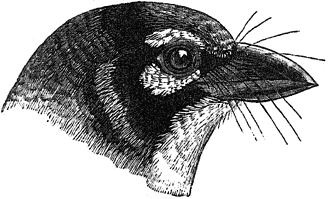|
Page 35 | prev page next page | ||||
|
Genus XANTHOLAEMA, Bonaparte, 1854 This genus comprises six small Barbets of the Oriental region, three out of the number occurring in India, Ceylon, and Burma. They are distinguished from all other Indian genera of Capitonidae by a differently shaped and more pointed wing, the 2nd primary, instead of being shorter than any other primary except the first, being always longer than the 8th, 9th, and 10th, and sometimes longer than the 6th. The bill is short and thick; the natal bristles long, often reaching to the end of the bill. The naked orbit is small. Prevailing colour green, with patches of red or yellow and other bright colours about the head.
Key to the Species
Fig. 27 - head of X. haematocephala Coloration: Loves black; forehead and sinciput crimson, a black band across the vertex extending down each side of the head behind the eye to the malar region; occiput and sides of neck greyish green, remainder of upper parts olivaceous green, varying to yellowish; primary-coverts and quills blackish, the quills with pale yellow inner margins, and some primaries pale-edged outside near the tip; a broad supercilium and a still broader streak below the eye, with the chin and throat, bright yellow; fore neck crimson, fringed below by golden yellow; breast, abdomen, and under tail coverts yellowish white, streaked longitudinally with olive or olivaceous green, especially on the flanks; tail faintly washed beneath with pale verditer-blue. The young is duller in colour and wants the crimson and black on the head. Bill black; irides dark hazel; nude orbital skin dull crimson; feet coral-red; claws black (Jerdon). Size: Length about 6.5; tail 1.5; wing 3.2; tarsus 0.8; bill from gape 0.9. Distribution: Common throughout the greater part of the Empire, with the exception of the Himalayas and the higher ranges of the peninsula and Burma. Rare in the Punjab, Sind, and Cutch, in southern Malabar (south of Ratnagiri), and in the damper forests of Ceylon, in Assam, the hill-tracts south of the Assam valley, and in southern Tenasserim. This bird is only found in the valleys of the outer Himalayas up to 2000 or 3000 feet. It ranges to the Malay peninsula, Sumatra, and the Philippines. Habits: One of the commonest and most familiar of Indian birds, the “Coppersmith” may be found in almost every garden, mango-grove or banyan tree, and its monotonous note took, took, took, resembling the tap of a hammer on metal, repeated at short regular intervals, is well known to most residents in the country. This bird, like other Indian Barbets, lives on fruit, but it takes insects occasionally. Captain Bulger (Ibis, 1868, p.218) saw it feeding on flying termites. It breeds in northern India in March, April, and May, earlier farther south, and in Ceylon from January to June, excavating a nest-hole of the usual kind and laying usually 3 or 4 eggs, which are white, fragile, with little or no gloss, and measure about 0.99 by 0.69.
Coloration: Crown and upper parts, wings and tail as in X. haematocephala, except that the general colour is grass-green. The band above and that below the eye, a spot at the base of the lower mandible on each side, chin, throat, and foreneck crimson, the malar and gular areas fringed with golden yellow; the black of the vertex runs down on each side behind the eye and the sub- ocular crimson patch but does not extend to the malar area; sides of head behind the black, and area between ear-coverts and throat, light grayish blue, lower parts from neck pale green, the feathers of the flanks darker green near the shafts. Bill black; irides red-brown; legs red (Jerdon). Size: Length 6.25; tail 1.5; wing 3.2; tarsus 0.8; bill from gape 0.85. Distribution: The forest-tracts near the Malabar coast as far north as Ratnagiri. Habits: Similar to those of X. haematocephala but the call is more subdued. The eggs were obtained by Mr. Bourdillon in south Travancore on March 6th, and are white, without gloss, and measure 0.98 by 0.65.
Coloration: Plumes associated with rictal bristles, a band above and one below the eye, chin, and throat golden yellow; a narrow black frontal band; no red spot at the base of the lower mandible on each side; a small crimson patch on the fore neck: otherwise similar to X. malabarica. Size: Length about 6; tail 1.4; wing 3.1; tarsus 0.75; bill from gape 0.85. Distribution: Peculiar to the island of Ceylon; found in the low country and up to about 2500 feet elevation. Habits: Similar to those of X. haematocephala, but the voice is more subdued. The breeding-season is from March till June; the eggs glossy white, measuring about 0.9 by 0.65. |
| ||||
| prev page :: next page | |||||
 birding.in
birding.in
| Birds | Bird Diagram | Ornithology | Indian Sites | Bird Watching | Migration | North India | Birds of India | Haryana |
All rights reserved. Copyright © 2005-2013 Birds and birding in India. Disclaimer
website: Free Java Guide & Tutorials
